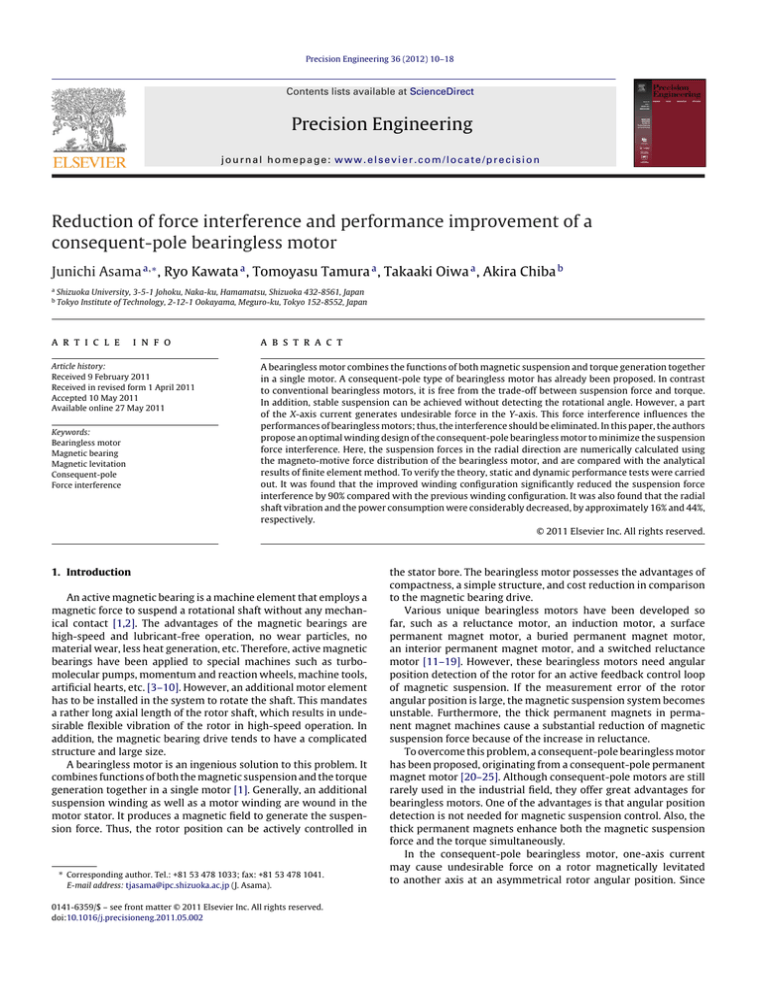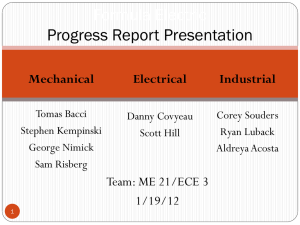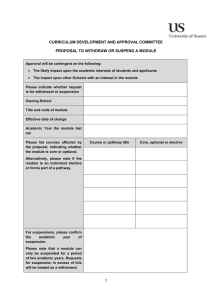
Precision Engineering 36 (2012) 10–18
Contents lists available at ScienceDirect
Precision Engineering
journal homepage: www.elsevier.com/locate/precision
Reduction of force interference and performance improvement of a
consequent-pole bearingless motor
Junichi Asama a,∗ , Ryo Kawata a , Tomoyasu Tamura a , Takaaki Oiwa a , Akira Chiba b
a
b
Shizuoka University, 3-5-1 Johoku, Naka-ku, Hamamatsu, Shizuoka 432-8561, Japan
Tokyo Institute of Technology, 2-12-1 Ookayama, Meguro-ku, Tokyo 152-8552, Japan
a r t i c l e
i n f o
Article history:
Received 9 February 2011
Received in revised form 1 April 2011
Accepted 10 May 2011
Available online 27 May 2011
Keywords:
Bearingless motor
Magnetic bearing
Magnetic levitation
Consequent-pole
Force interference
a b s t r a c t
A bearingless motor combines the functions of both magnetic suspension and torque generation together
in a single motor. A consequent-pole type of bearingless motor has already been proposed. In contrast
to conventional bearingless motors, it is free from the trade-off between suspension force and torque.
In addition, stable suspension can be achieved without detecting the rotational angle. However, a part
of the X-axis current generates undesirable force in the Y-axis. This force interference influences the
performances of bearingless motors; thus, the interference should be eliminated. In this paper, the authors
propose an optimal winding design of the consequent-pole bearingless motor to minimize the suspension
force interference. Here, the suspension forces in the radial direction are numerically calculated using
the magneto-motive force distribution of the bearingless motor, and are compared with the analytical
results of finite element method. To verify the theory, static and dynamic performance tests were carried
out. It was found that the improved winding configuration significantly reduced the suspension force
interference by 90% compared with the previous winding configuration. It was also found that the radial
shaft vibration and the power consumption were considerably decreased, by approximately 16% and 44%,
respectively.
© 2011 Elsevier Inc. All rights reserved.
1. Introduction
An active magnetic bearing is a machine element that employs a
magnetic force to suspend a rotational shaft without any mechanical contact [1,2]. The advantages of the magnetic bearings are
high-speed and lubricant-free operation, no wear particles, no
material wear, less heat generation, etc. Therefore, active magnetic
bearings have been applied to special machines such as turbomolecular pumps, momentum and reaction wheels, machine tools,
artificial hearts, etc. [3–10]. However, an additional motor element
has to be installed in the system to rotate the shaft. This mandates
a rather long axial length of the rotor shaft, which results in undesirable flexible vibration of the rotor in high-speed operation. In
addition, the magnetic bearing drive tends to have a complicated
structure and large size.
A bearingless motor is an ingenious solution to this problem. It
combines functions of both the magnetic suspension and the torque
generation together in a single motor [1]. Generally, an additional
suspension winding as well as a motor winding are wound in the
motor stator. It produces a magnetic field to generate the suspension force. Thus, the rotor position can be actively controlled in
∗ Corresponding author. Tel.: +81 53 478 1033; fax: +81 53 478 1041.
E-mail address: tjasama@ipc.shizuoka.ac.jp (J. Asama).
0141-6359/$ – see front matter © 2011 Elsevier Inc. All rights reserved.
doi:10.1016/j.precisioneng.2011.05.002
the stator bore. The bearingless motor possesses the advantages of
compactness, a simple structure, and cost reduction in comparison
to the magnetic bearing drive.
Various unique bearingless motors have been developed so
far, such as a reluctance motor, an induction motor, a surface
permanent magnet motor, a buried permanent magnet motor,
an interior permanent magnet motor, and a switched reluctance
motor [11–19]. However, these bearingless motors need angular
position detection of the rotor for an active feedback control loop
of magnetic suspension. If the measurement error of the rotor
angular position is large, the magnetic suspension system becomes
unstable. Furthermore, the thick permanent magnets in permanent magnet machines cause a substantial reduction of magnetic
suspension force because of the increase in reluctance.
To overcome this problem, a consequent-pole bearingless motor
has been proposed, originating from a consequent-pole permanent
magnet motor [20–25]. Although consequent-pole motors are still
rarely used in the industrial field, they offer great advantages for
bearingless motors. One of the advantages is that angular position
detection is not needed for magnetic suspension control. Also, the
thick permanent magnets enhance both the magnetic suspension
force and the torque simultaneously.
In the consequent-pole bearingless motor, one-axis current
may cause undesirable force on a rotor magnetically levitated
to another axis at an asymmetrical rotor angular position. Since
J. Asama et al. / Precision Engineering 36 (2012) 10–18
this suspension force interference is critical to the control system,
it should be reduced as much as possible to improve positioning accuracy and reduce power consumption. In a previous
report, the radial suspension force of a consequent-pole bearingless motor with distributed suspension windings was investigated
[21]. Although it has fewer harmonic components in the magnetomotive force (MMF) distribution, the number of conductors is
increased. Recently, concentrated windings have been employed
in industrial motors for copper loss reduction and downsizing.
However, the concentrated windings have considerable MMF harmonics; thus, force interference is a problem in the bearingless
motor.
The aim of this paper is to reduce the suspension force interference in the consequent-pole bearingless motor with concentrated
windings and to improve its performances. Force interference
reduction is realized by improving the coil arrangement of the
stator. Radial suspension force was numerically calculated with
the MMF distribution in the air-gap, including the high harmonic
components of the suspension windings. To verify the theory, the
calculated results were compared to the results of finite element
method (FEM) analysis and experiments. It was found that the
improved winding configuration could significantly reduce both
the force interference and the suspension force variations. Noticeable effects on both the rotor vibration and the power consumption
were demonstrated.
2. Numerical analysis
total suspension force is generated by a vector sum of the X- and
Y-direction forces.
As shown in Fig. 1(a), when the suspension current ix is provided
at a symmetrical angular position, e.g., the mechanical rotational
angles of 0◦ and 45◦ , the resulting direction of the suspension force
corresponds to the X-axis. However, when the rotor is positioned
at asymmetrical angular positions, an undesirable suspension force
component Fyx is induced to the Y-axis, as shown in Fig. 1(b). Since
the Fyx acts as an interference force to the control system, this
force interference should be minimized for precise positioning and
power reduction. In this paper, the angle of suspension force with
respect to the X-axis is defined as the error angle e :
e = tan−1
Fyx
Fx
(1)
2.2. Conventional suspension winding configuration
In this section, we analyze the suspension force when the twopole magnetic flux along the X-axis is generated. Fig. 2 shows an
analysis model of the consequent-pole bearingless motor. A commonly used eight-pole rotor structure with 12 slots is considered.
The stator has two-pole three-phase suspension windings. The Xand Y-axes are fixed to the stator. The symbol is the angle from
the X-axis. The rotational angle of the rotor ωt is the product of the
rotational speed ω and time t. The symbols p and i are the arc
angles of the permanent magnet and the iron part, respectively.
2.1. Consequent-pole bearingless motor
Fig. 1 shows the structure and the principle of the suspension force generation of the consequent-pole bearingless motor.
Radially magnetized permanent magnets are inset into the rotor
iron parts. These permanent magnets produce bias magnetic fluxes
which flow through the air-gaps, stator core, and rotor core. The
iron parts are consequently polarized. The stator has additional suspension windings for the suspension force generation as shown.
Conventional motor windings for the torque generation are also
arranged in the stator; however, these are not shown for simplicity. When the current flows in the suspension windings, two-pole
suspension magnetic flux is generated. Then, the flux densities in
the air-gaps around the rotor are unbalanced because of the suspension flux superposition. As a result, suspension force is generated in
the radial direction. For instance, the negative X-axis force is generated by providing negative current in the suspension winding.
The Y-axis force is also generated by currents in another suspension coil perpendicular to the drawn suspension coil in Fig. 1. The
11
Fig. 2. . Analysis model of a consequent-pole bearingless motor.
Fig. 1. . Structure and principle of the suspension force generation of a consequent-pole bearingless motor.
ID
801336
Title
Reductionofforceinterferenceandperformanceimprovementofaconsequent-polebearinglessmotor
http://fulltext.study/article/801336
http://FullText.Study
Pages
9


